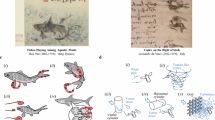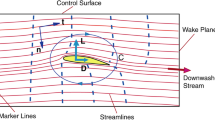Abstract
Modeling the flow around a deformable and moving surface is required to calculate the forces exerted by a swimming or flying animal on the surrounding fluid. Assuming that viscosity plays a minor role, linear potential models can be used. These models derived from unsteady airfoil theory are usually divided in two categories depending on the aspect ratio of the moving surface: for small aspect ratios, slender-body theory applies while for large aspect ratios two-dimensional or lifting-line theory is used. This paper aims at presenting these models with a unified approach. These potential models being analytical, they allow fast computations and can therefore be used for optimization or control.


Similar content being viewed by others
References
Childress S (1981) Mechanics of swimming and flying. Cambridge University Press, Cambridge
Dowell EH, Hall KC (2001) Modeling of fluid-structure interaction. Ann Rev Fluid Mech 33:445–490
Lighthill J (1987) Mathematical biofluiddynamics. SIAM, Philadelphia
Taylor GI (1952) Analysis of the swimming of long and narrow animals. Proc R Soc Lond Ser A 214(1117):158–183
Wu TY (2001) Mathematical biofluiddynamics and mechanophysiology of fish locomotion. Math Methods Appl Sci 24:1541–1464
Wu TY (2002) On theoretical modeling of aquatic and aerial animal locomotion. In: van der Giessen E, Wu TY (eds) Advances in applied mechanics, vol 38. Elsevier, Amsterdam, pp 291–353
Cheng JY, Pedley TJ, Altringham JD (1998) A continuous dynamic beam model for swiming fish. Philos Trans R Soc Lond B 353:981–997
Lighthill MJ (1960) Note on the swimming of slender fish. J Fluid Mech 9:305–317
Lighthill MJ (1971) Large-amplitude elongated-body theory of fish locomotion. Proc R Soc Lond B 179:125–138
Guermond JL, Sellier A (1991) A unified unsteady lifting-line theory. J Fluid Mech 229:427–451
Wu TYT (1961) Swimming of a waving plate. J Fluid Mech 10:321–344
Morse PM, Feshbach H (1953) Methods of theoretical physics. McGraw-Hill, New York
Hadamard J (1932) Lectures on Cauchy’s problem in linear differential equation. Dover, New York
Mangler KW (1951) Improprer integrals in theoretical aerodynamics. Tech. Rep. Aero 2424, British Aeronautical Research Council
Van Dyke M (1975) Perturbation methods in fluid mechanics. Parabolic, Stanford
Van Dyke M (1964) Lifting-line theory as a singular perturbation problem. Appl Math Mech 28:90–101
Watkins CE, Runyan HL, Woolston DS (1955) On the kernel function of the integral equation relating the lift and downwash distributions of oscillating finite wings in subsonic flow. Tech. Rep. TR-1234, NACA
Katz J, Plotkin A (2001) Low-speed aerodynamics, 2nd edn. Cambridge University Press, Cambridge
Tuck EO (1993) Some accurate solutions of the lifting surface integral-equation. J Aust Math Soc Ser B 35:127–144
Albano E, Rodden WP (1969) A doublet-lattice method for calculating lift distributions on oscillating surfaces in subsonic flows. AIAA J 7(2):279–285
Rodden WP, Taylor PF, McIntosh SC (1998) Further refinement of the subsonic doublet-lattice method. J Aircr 35(5):720–727
Cheng JY, Zhuang LX, Tong BG (1991) Analysis of swimming three-dimensional waving plates. J Fluid Mech 232:341–355
Bisplinghoff RL, Ashley H, Halfman RL (1983) Aeroelasticity. Dover, New York
Theodorsen T (1935) General theory of aerodynamic instability and the mechanism of flutter. Tech. Rep. TR-496, NACA
Eloy C, Lagrange R, Souilliez C, Schouveiler L (2008) Aeroelastic instability of cantilevered flexible plates in uniform flow. J Fluid Mech 611:97–106
Eloy C, Souilliez C, Schouveiler L (2007) Flutter of a rectangular plate. J Fluids Struct 23:904–919
Acknowledgement
This work was sponsored by the French ANR under the project ANR-06-JCJC-0087.
Author information
Authors and Affiliations
Corresponding author
Rights and permissions
About this article
Cite this article
Eloy, C., Doaré, O., Duchemin, L. et al. A Unified Introduction to Fluid Mechanics of Flying and Swimming at High Reynolds Number. Exp Mech 50, 1361–1366 (2010). https://doi.org/10.1007/s11340-009-9289-7
Received:
Accepted:
Published:
Issue Date:
DOI: https://doi.org/10.1007/s11340-009-9289-7




